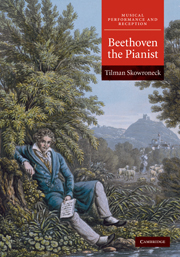Book contents
- Frontmatter
- Contents
- Acknowledgments
- Abbreviations and conventions
- Introduction
- PART I BEETHOVEN, HIS PLAYING, AND HIS INSTRUMENTS
- PART II SOUND IDEAL AND PERFORMANCE
- PART III SOUND IDEAL, NOTATION, AND STYLISTIC CHANGE
- Introduction
- 7 Common touch and legato
- 8 The performance of Beethoven's trills
- Epilog
- Bibliography
- Index
Introduction
from PART III - SOUND IDEAL, NOTATION, AND STYLISTIC CHANGE
Published online by Cambridge University Press: 06 July 2010
- Frontmatter
- Contents
- Acknowledgments
- Abbreviations and conventions
- Introduction
- PART I BEETHOVEN, HIS PLAYING, AND HIS INSTRUMENTS
- PART II SOUND IDEAL AND PERFORMANCE
- PART III SOUND IDEAL, NOTATION, AND STYLISTIC CHANGE
- Introduction
- 7 Common touch and legato
- 8 The performance of Beethoven's trills
- Epilog
- Bibliography
- Index
Summary
This part is devoted to two topics that have played a major role in the discussion of the development of style in the early nineteenth century. Both topics have also been seen as important ingredients of Beethoven's pianism. In Chapter 7, I will discuss Beethoven's alleged preference for legato and present a history of the development of his legato notation. Chapter 8 discusses the interpretation of Beethoven's trills.
The task of managing the triangle of performance conventions, Beethoven's notation, and execution is complex. Whenever we try to pinpoint one of these elements in order to view its relationship to the others, we bypass some unanswered question. For example, it is difficult to demonstrate Beethoven's role as a stylistic innovator in a narrative that makes use of musical examples if we neglect to analyze what the intent of his notation was. Would he also notate his ideas in a novel manner, or would he rely on conventional methods to express a novel thought? In the case of Beethoven's trills, an uncertainty here could produce directly opposed conclusions. In the discussion about Beethoven's legato style, the question is whether he learned it by interpreting Clementi's or Dussek's notation, by experimenting for himself and only adapting that notation, or by listening to other performers who played legato. In passages that lack a specifically marked articulation, we must know whether the intended “background level” of articulation for Beethoven was modern (assuming that “modern” means legato) or traditional (meaning that any variation of a late eighteenth-century common touch could apply).
- Type
- Chapter
- Information
- Beethoven the Pianist , pp. 171Publisher: Cambridge University PressPrint publication year: 2010



